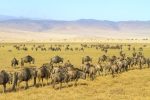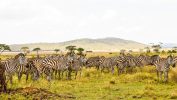When is the best time to visit Tanzania?
The weather is probably the most important thing to consider when planning your trip to Tanzania for safari. Tanzania has two rainy seasons, a long one that usually occurs between March and May and short one that takes place between November and December. Going on safari in Tanzania is possible all year round, though you will not see the same animals all the time and the landscapes look different depends on the seasons. So it depends what you want to see, to do or to experience when you visit. There are many factors that influence the time of the year to visit, including weather conditions, cost of travel and depends on what activities you are interested in during your visit to Tanzania, so answers about when is the best time to visit Tanzania is obviously different for everyone. It’s a year round travel and safari destination where each season has its own reasons to visit.
Many people say that, the rainy season is not the right time to visit Tanzania, but we think that’s not always the case. On the contrary, the rainy season is when nature is most beautiful green, fascinating and flourishing. There is no such thing as a bad time for your safari in Tanzania, when to visit Tanzania for safari just depends on your preferences. If you love adventure and authenticity, Tanzanian Nature is beautiful during the rainy season, all you need to do is find the right Safari company with the best guides in the country, and we are the ones.
The best time to visit Tanzania for wildlife experiences is during late June through October; this is during the dry season, when wildlife viewing and game drives are spectacular. The wildebeest migration in Serengeti is usually during June through July which is considered as the best time to visit Serengeti. The right time to see the wildebeest calving is late January through February which is also the best time to visit Tanzania.
The southern and western circuit parks are best visited during the dry season (From June to October), unlike the popular northern circuit parks that can be visited all year-round.
January is the beginning of the short dry season in Tanzania. There is a slight chance of rain, the temperature is getting higher and the humidity is building. You can still to come and visit as the rates are lower. It’s also the right time to see the newborn babies in Serengeti National Park.
Migration is still occurring in Ndutu. The weather is hot and humidity with a chance of short rains. February is also a great time to see the newborn babies in Serengeti, especially the wildebeest. It’s a start of calving season when thousands of wildebeest give birth. This is an excellent time to visit Serengeti as Predators are active and breeding due to plenty of prey. Approximately 500,000 wildebeest calves are born from late January through February and March.
Migration herds are starting to leave Ndutu, heading west towards Grumeti.
Even though, rainy season starts in March, the month still experiences several days of sunshine, humidity and warmth. March is also the low season in Tanzania, so there should also be less tourists around and prices are reduced which is great news for budget travellers.
Overall, January to March is calving season, it’s a great safari opportunity to see the young wildebeest and zebras. It’s even common to see calves being born. However, this is not the best time to see the migration on the move so don’t expect stampeding herds or dramatic river crossing.
This is during the long rainy season, it rains often and it is a bit less warm. The rains make everything lush green, beautiful and the animals are active in the parks, with adequate sources of water everywhere, it’s a bit difficult to spot some animals but our experienced guides know where to go and what to do. This is what we call low season in Tanzania when there are fewer tourists in Tanzania and almost all the lodges and hotels offer discount for accommodation. These might be the best months for budget travellers to visit Tanzania because you can get some excellent rates, so if you are on a tight budget this may be the right time for you to visit Tanzania.
This is green season, for travellers looking to do a little bit of everything in Tanzania, June is possibly the best month to visit as it’s the beginning of the dry season. The rains have come to an end, the savannahs are starting to change from green to yellow, and wildlife sightings improve as the vegetation slowly recedes. The Wildebeest Migration may have stopped at the Grumeti River, building up numbers before they attempt their extremely dangerous crossing.
This is the beginning of the peak season and is regarded as the best month to visit Tanzania and go on safari. The Migration is in the north of Serengeti moving towards Masai Mara in Kenya and Elephants start gathering in Tarangire. July is the best month to see the Migration in Serengeti. July is also one of the driest months in Tanzania, which makes it perfect for wildlife sightings, beach holidays and family vacations.
During the dry season, animals gather together near water sources putting predators and prey in close proximity and making some exciting game viewing. As a by – product of the water shortages the vegetation is thin, and thus improving visibility of animals.
Because the dry season is in full swing and the vegetation is limited, August is also a great month to visit for wildlife viewing. August is also ideal for beach vacations, as temperatures will be moderately warm.
This is another dry season with low humidity, September is also one of the best months to visit Tanzania for wildlife experiences as the wildebeest and zebras will have begun migrating back to Serengeti.
This is also what most people believe to be the best time to visit Tanzania. The migration is in Kenya during this time, but the game viewing in central Serengeti is still amazing. Southern parks are particularly rewarding during this time of the year.
This is the beginning of the short rains, November sees the end of the Great Migration and, subsequently, some great game viewing opportunities. This is also a right time for budget travellers to visit as there are fewer crowds of tourists and the prices are lower. There are still some great chances to spot animals on safari in November.
While December is technically part of the short rainy season in Tanzania, this generally doesn’t last too far into the month, great news for the Christmas and New Year’s travellers
December is a great time for birdwatchers, as migratory birds arrive in the country during this month. So the advantage of coming to Tanzania for Safari are, good prices, less tourists, beautiful colors and lots of birds around.
The Best time to see the Great Migration of the Wildebeest
The Great Migration, when over 2 millions of Wildebeest and Zebras travel from Serengeti National Park in Tanzania to Masai Mara National Reserve in Kenya, this is one most incredible natural phenomenons in the world, so it’s no wonder why travellers dream of seeing it in person. The best time of the year to see the Great Migration in Tanzania is from late June to October, however the travellers who can make the trip later can also travel to Masai Mara to see the result of migration.
From June to August is the best time for a safari in Tanzania as well. The spectacular Mara River crossing occurs June-July and due to drier weather means more wildlife around waterholes.
Certainly, one of the major attractions when visiting Tanzania is the large herds of migratory Wildebeest and their followers such as Zebras. These herds constantly move in search of new pastures, so their location varies with time of the year. For the most part of the herds have moved north into Kenya during July – September season, so they are largely absent from the Serengeti during that time.






